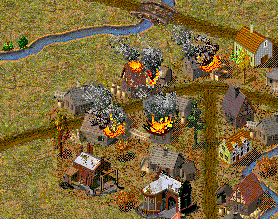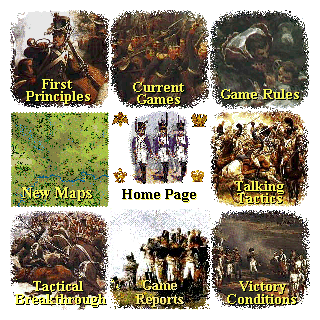|
|
|
A few new ideas for umpired Battleground actions
or those played by responsible individuals seeking a realistic wargame
Colour parties
No regiment was complete without its regimental standard, colour, eagle or
emblem of whatever name (but never "flag!"). To fill this omission in BG, it is
relatively easy to add an icon for each infantry type showing a standard bearer
who can accompany, or indeed be accompanied by, his regiment on the battlefield.
Normally residing with the 1st Bn or otherwise in the midst of its battalions,
the standard would be both symbolic and practical, serving as guide and rallying
point while embodying the pride and spirit of the regiment. As such, these
prominent features were often fought over, their loss being considered akin to
the tragic and the winning of that of the enemy tangible proof of triumph.
Each regiment will therefore have a "25-strong" colour party of the highest
morale, required to change formation with any unit it is with, but unarmed and
not affecting the game mechanics in any way except adding those few men to the
local strength (25 are deducted from the 1st Bn, so the army strength remains
the same).
 In this example, the
Vladimir regiment's colour party is at the head of its two battalions, in
column, while the neighbouring regiment has its colours between its battalions
accompanied only by the brigade commander - inadvisable unless in very safe
circumstances well away from the enemy.
In this example, the
Vladimir regiment's colour party is at the head of its two battalions, in
column, while the neighbouring regiment has its colours between its battalions
accompanied only by the brigade commander - inadvisable unless in very safe
circumstances well away from the enemy.
The game needs to be viewed with the option of 'Unit flags off' selected, so
that the colour parties are the only standards visible and therefore given due
prominence.
The colour party should never be subject to fire, as another officer would step
forward to carry the colour if the previous one fell and no colour can be
captured by fire, only by seizure in close combat. The colour party may not be
left in the rear to keep it from danger, but must remain with the body of the
regiment. In a case such as the British Coldstream and 3rd Guards at Waterloo,
when all but two companies of each battalion detached to Hougoumont, the body of
the regiment comprised the remaining two companies, which is where the colours
stayed. The colour party should not be obliged to melee assault, as the game
tends to eliminate small elements, though leaving it behind in an advance due to
a successful assault could be as dangerous in some circumstances.
The capture of an enemy colour will be immediately apparent and this could be
made to affect the results of a battle, perhaps by counting as 100 casualties or
more. Apart from this, the prestige and ignominy for captor and loser will
further reflect reality for them.
Artillery ammunition
Scales of available ammunition are detailed elsewhere and the presence of a
supply train for artillery brigades is a common feature in NHWC OOBs. Perhaps
there is a more realistic way of connecting the two and making the positioning
of batteries and the ammunition trains more interdependent.
In addition to a general supply train for artillery formations, mostly to
reflect the additional needs of horse-based units, a specific ammunition train
for each battery can be included. This have to accompany the battery, in
fact being part of the 'unit', at a distance of no more than a few hundred yards
(say, 3 hexes). The route between guns and ammunition would have to be clear for
the passage of supply to the guns, though friendly units are not considered as being obstacles. Failure to have the ammunition train so
positioned could result in the battery being unable to fire.
This would give a much more cluttered battlefield where artillery are present,
all the more realistic when compared to this diagram of Napoleon's grand battery
at Waterloo, which shows the number of vehicles involved.

A battery unit in BG, without its
additional train,
represents the guns and first line ammunition, up to half of the total, in one
wagon per piece. The additional train would therefore be half the size of the
battery for calculating road column length, except for heavy artillery (12pdrs),
which had three wagons for each gun, so their train
additional to those with the guns is equal to the battery size. So, in the above
diagram, the guns, a-frame limbers and the first continuous line of wagons would
be the battery as depicted in the game. The remaining vehicles would be the
train unit.
The Prussian army can be treated slightly differently, as they used fewer but larger ammunition wagons. Their 6-pounder batteries have a train element only ¼ of the number of guns in strength. 12-pounders still need twice as many vehicles, so they are ½ the strength of the battery.
In each case, the ratio of one gun to 25 men is used, so a six-wagon train is represented by a unit 150 "men" strong.
A battery having used all its own ammunition might be able to draw on the supply of an adjacent battery of the same type and
under the same formation command, after an interval of, say, one 15-minute turn
or three 5-minute turns. This will work best with the method of individual
battery ammunition reckoning, described on the artillery ammunition page.
Burning buildings and other structures
I was reading that the artillery tactic for
defending villages was to set up alongside or on ground overlooking them because of the
danger of buildings catching fire and endangering the ammunition. There are cases of fires
affecting battles, including Borodino and Waterloo.
I don't know of any way of introducing fire or its effect into a BG game engine, but it
can be umpired quite easily. There would be little damage to units, as they would leave
immediately and then avoid the area of the fire, though artillery in the hex
would be open to possible damage. This movement can be enforced easily. The
location could be made impossible to enter by adjusting the main.map file, but again with
an umpire in control this is not vital. The appearance of a fire can be added to both 2D
and 3D maps during a battle. Players can either download a whole new map or, with the use
of a graphics editor (such as MS Paint) add the graphic to their existing maps.
If a fire burns out or is extinguished a new section of bitmap can be pasted in and the
main.map altered to represent whatever the effect of an area of ruins might be.
Before |
Burning |
After |
 |
 |
 |
Digging defences
It is possible for any formation to dig defences or throw up earthworks prior to a battle.
These are quite easy to add to a map, or to remove (Borodino without the redoubts, anyone?).
It may also be possible for defences to be constructed during a battle and added to the
map. This would not be done by units currently fighting but might involve those away from
the action or in the rear of the front line.
Those familiar with BG ACW publications will know of the ability of units to build breastworks,
well this can be done in the Napoleonic version under the control of an umpire. Materials
would have to be at hand, so woodland or buildings should be at least adjacent. Barricades
or breastworks constructed in the short time scales provided within a battle would be as
effective as cover and an obstacle as a low wall, though they may only count as a hedge if
hastily built or materials are scarce. The main.map file can be amended to include
earthworks and other barricades and the visual aspect added to the bitmap as for fires.
